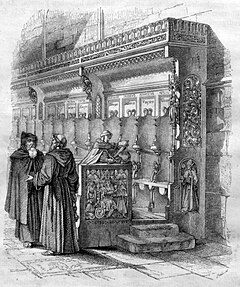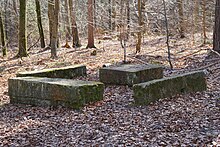Hospital Church (Stuttgart)
The Hospital Church is the third large medieval church to be founded in the old town of Stuttgart and today the center of the "Evangelical Hospital Church Community Stuttgart" within the Stuttgart Church District .
Hospital Church
The Hospital Church was initially a towerless, three-aisled late Gothic hall church with a single-nave long choir, which the builder Aberlin Jörg ( collegiate church , Leonhard's Church ) had built for the Dominican order between 1471 and 1493 . After the monastery was dissolved during the Reformation , a hospital was set up in the empty buildings . The church became a parish church of the collegiate parish and received a tower on the south side of the choir in the 17th century. Only a few pieces of the original equipment have survived. Including the Sachsenheim altar from 1489 and tombs from the 16th and 17th centuries. The choir stalls were set up in the Leonhardskirche after the Second World War.
In 1944 the structure was badly damaged by bombs. After the war, only the choir and the tower were restored according to plans by Rudolf Lempp . The nave was preserved as a ruin as a memorial against the war .
In the choir is the original of the crucifixion group from 1501 by Hans Seyfer , which adorned the place behind the Leonhardskirche until before the war . Today there is a copy from 1976.
The composer Leonard Lechner is buried in the Hospital Church.
A 6-part bronze bell hangs in the tower with the notes h ° , e ' , f sharp' , g ' , a' and b ' .
Protestant education center Hospitalhof
The church and the buildings of the education center form a structural unit around an inner courtyard. The building of the education center has been completely rebuilt since 2012.
See also Helmut A. Müller , the head of the Protestant Education Center Hospitalhof Stuttgart .
Reformation monument
The Württemberg Reformation monument in front of the former south facade of the Hospital Church was created in 1917 by the sculptor Jakob Brüllmann on the occasion of the four-centenary of Luther's posting of the theses and made of local shell limestone .
The victoriously resurrected Christ with the victory flag is enthroned in the center of the enclosed facility. It is surrounded by seated figures of the German reformer Martin Luther and the reformer of Württemberg Johannes Brenz, as well as reliefs with scenes from rural life and reliefs and inscription panels from the Reformation era.
Choir stalls
The choir stalls were made in 1490 and 1493 by Hans Ernst von Böblingen or Conrad Zolner and Hans Haß and placed in the choir of the Hospital Church. During the Second World War, the choir stalls, which in 1943 still had 63 seats, were salvaged from the Thomaskirche in Stuttgart-Kaltental . After the Second World War, the largely destroyed Leonhard Church was rebuilt until 1950, while the fate of the hospital church, which had been destroyed except for the tower, choir and south facade, remained uncertain. The remaining segments of the choir stalls were therefore placed in the Leonhardskirche, where they remained even after the hospital church was partially rebuilt in 1960.
The preserved choir stalls in the Leonhardskirche consist of six rows of oak seats with 57 of the original 87 seats. The seats are decorated with rich carvings on the cheeks, the knobs of the armrests and the misericordia , and on the backrests and dorsal inscriptions with the names of fraternal monasteries. One of the two originally rear rows of seats is crowned by a canopy .
Baptismal font
The baptismal font, created in 1809, ended up in the Sindelfingen Forest with other rubble after the church was destroyed in 1948 . The district forester Heinrich Spring had it converted into a memorial there and given the inscription " sic transit gloria mundi ". On September 12, 2014, it was recovered, restored and put back in its old location. Because of the structural changes, the square is now in the courtyard of the hospital church. The remaining parts with the inscription have remained in the forest as a memorial.
literature
- Carl Alexander von Heideloff (editor): The art of the Middle Ages in Swabia. Monuments of architecture, sculpture and painting. Stuttgart 1855–1864, pages 28–31, plates VII – VIII.
- Christa Mack: sacred space. Collegiate Church, St. Leonhard and Hospital Church in the Middle Ages. Booklet accompanying the exhibition Sacred Space. Collegiate Church, St. Leonhard and Hospital Church in the Middle Ages; September 24 to November 26, 2004. Stuttgart: City Archives, 2004.
- Eduard von Paulus: The gravestones found in the Hospital Church in Stuttgart in August 1878. In: Württembergische Vierteljahrshefte für Landesgeschichte, Volume 2, 1879, pages 236–242.
- Eduard von Paulus: The art and antiquity monuments in the Kingdom of Württemberg, volume: Inventories [Neckarkreis]. Stuttgart 1889, pages 20-21.
Web links
- official page
- Detailed, illustrated documentation
- Hospital Church (Stuttgart). In: arch INFORM .
- Picture gallery
- The rebuilding of the hospital courtyard Article of the StZ from July 2011, 23 million euros for the new hospital courtyard
- Stuttgart is changing (construction sites in Stuttgart :) The hospital quarter in March Article of the StZ from March 2013 (with 30 photos)
- Spring on the construction site in the Hospitalhof: The area is to be expanded and upgraded as a center for church educational work. The latest pictures from the construction site: The hospital quarter in April Article of the StZ from April 2013 (with 33 photos)
- A font from the forest Article of the StZ from September 2014
- Bernhard Neidiger: Hospital Church, published on April 19, 2018 in: Stadtarchiv Stuttgart, Stadtlexikon Stuttgart
Coordinates: 48 ° 46 ′ 40 ″ N , 9 ° 10 ′ 22 ″ E



